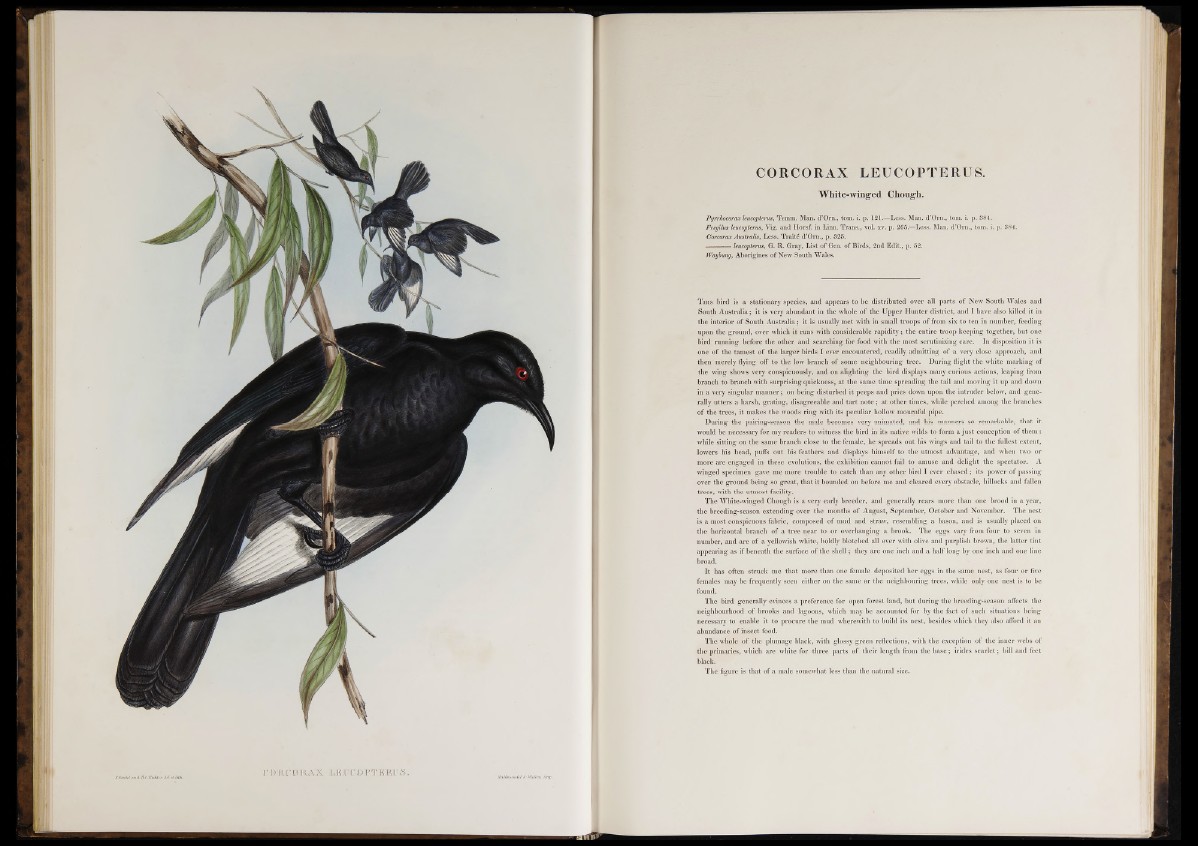
CORCORAX LEUCOPTERUS.
White-winged Chough.
Pyrrhocorax leucopterus, Temm. Man. d’Om., tom. i. p. 121.—Less. Man. d’Orn., tom. i. p. 384.
Fregilus leucopterus, Vig. and Horsf. in Linn. Trans., vol. xv. p. 265.—Less. Man. d’Orn., tom. i. p. 384.
Corcorax Australis, Less. Traité d’Orn., p. 325.
------------ leucopterus, G. R. Gray, List of Gen. of Birds, 2nd Edit., p. 52.
Waybung, Aborigines of New South Wales.
T h is bird is a stationary species, and appears to be distributed over all parts o f New South Wales and
South Australia; it is very abundant in the whole o f the Upper Hunter district, and I have also killed it in
the interior of South Australia; it is usually met with in small troops o f from six to ten in number, feeding
upon the ground, over which it runs with considerable rapidity; the entire troop keeping together, but one
bird running before the other and searching for food with the most scrutinizing care. In disposition it is
one of the tamest of the larger birds I ever encountered, readily admitting of a very close approach, and
then merely flying off to the low branch of some neighbouring tree. During flight the white marking of
the wing shows very conspicuously, and on alighting the bird displays many curious actions, leaping from
branch to branch with surprising quickness, at the same time spreading the tail and moving it up and down
in a very singular manner; on being disturbed it peeps and pries down upon the intruder below, and generally
utters a harsh, grating, disagreeable and tart note; at other times, while perched among the branches
o f the trees, it makes the woods ring with its peculiar hollow mournful pipe.
During the pairing-season the male becomes very animated, and his manners so remarkable, that it
would be necessary for my readers to witness the bird in its native wilds to form a just conception of them:
while sitting on the same branch close to the female, he spreads out his wings and tail to the fullest extent,
lowers his head, puffs out his feathers and displays himself to the utmost advantage, and when two or
more are engaged in these evolutions, the exhibition cannot fail to amuse and delight the spectator. A
winged specimen gave me more trouble to catch than any other bird I ever chased; its power of passing
over the ground being so great, that it bounded on before me and cleared every obstacle, hillocks and fallen
trees, with the utmost facility.
The White-winged Chough is a very early breeder, and generally rears more than one brood in a year,
the breeding-season extending over the months of August, September, October and November. The nest
is a most conspicuous fabric, composed of mud and straw, resembling a bason, and is usually placed on
the horizontal branch of a tree near to or overhanging a brook. The eggs vary from four to seven in
number, and are o f a yellowish white, boldly blotched all over with olive and purplish brown, the latter tint
appearing as if beneath the surface o f the shell; they are one inch and a half long by one inch and one line
broad.
It has often struck me that more than one female deposited her eggs in the same nest, as four or five
females may be frequently seen either on the same or the neighbouring trees, while only one nest is to be
found.
The bird generally evinces a preference for open forest land, but during the breeding-season affects tbe
neighbourhood o f brooks and lagoons, which may be accounted for by the fact of such situations being
necessary to enable it to procure the mud wherewith to build its nest, besides which they also afford it an
abundance of insect food.
The whole of the plumage black, with glossy green reflections, with the exception o f the inner webs of
the primaries, which are white for three parts o f their length from the base; irides scarlet; bill and feet
black.
The figure is that of a male somewhat less than the natural size.